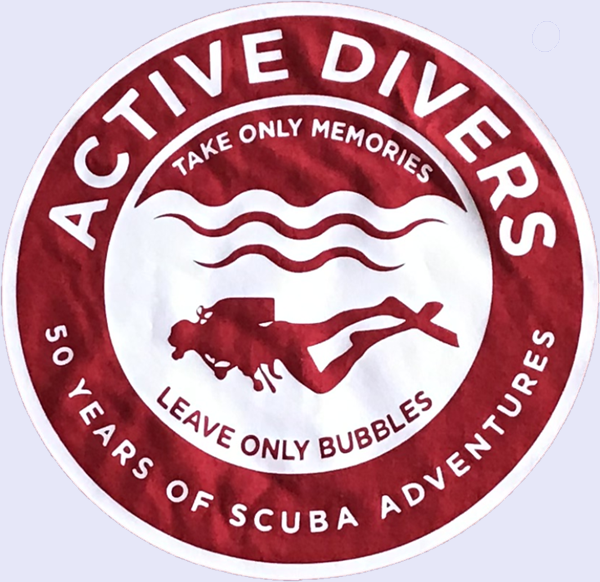![]()
- 2019 Coral Restoration Dive
- Garbage In, Garbage Out
- Active Divers Member Receives Women Divers Hall of Fame Scholarship
- Jupiter Sea Turtle Dive
- Tropical Reef Corals
Are Moving Toward the Poles
- No-Fault Dive Insurance
- Thar Be Whales
- Welcome New Members
- Lobsters are Cannibals?
- Test Your Knowledge
- Love is Strange
- Newsletter Delivery Options
- Email or Address Change?
- T-Shirts For Sale
- Active Divers Guidelines & Policies
2019 Coral Restoration Dive Program
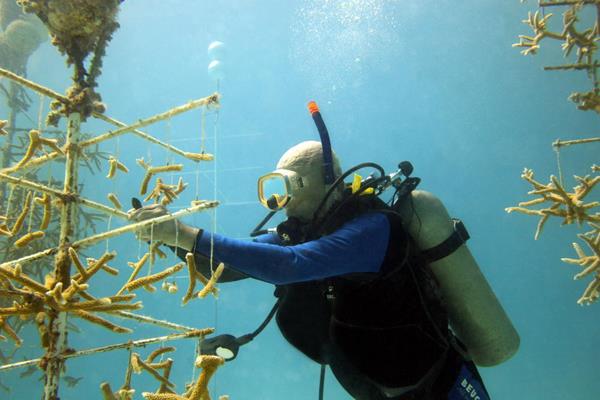
If you love the splendor of colorful tropical reefs (and what diver doesn’t?), now is the time register for one of the remaining slots in our 2019 Active Divers collaborative program with the Coral Restoration Foundation. This year’s event is on Saturday, June 15, from 9 a.m. to 5 p.m. in Key Largo and Tavernier. If you join us that day, I can assure you that you will feel an unparalleled sense of satisfaction when you see tiny coral specimens you transplant onto a barren reef grow and mature.
Don’t know anything about marine science and coral transplanting techniques? There is no need to worry. CRF trains every diver in morning lecture and hands-on sessions in its state-of-the-art facility, located at 5 Seagate Blvd in Key Largo, right next door to the Pilot House Restaurant. There we will learn some of the science about threats to the reef systems; the latest techniques for taking cutting and prepping baby corals for outplanting, how to transplant specimens onto the reef, maintaining previously-planted coral garden,; and documenting the successes of our efforts.
If you are not a member of Active Divers and wish to participate in the 2019 Coral Restoration Dive, follow these easy steps to join:
- Complete the online application
and waiver, found at
https://activedivers.org/Online_Application.html. Please note: there are two parts the application and the waiver, each with a separate "Submit" button. - Send a color photo or scan of your certification card to ActiveDiversInfo@gmail.com.
- Pay for the dive via the PayPal link at the bottom of this
page. Note: Membership fees for new members are
automatically waived for 2019, and current members will have
their memberships extended one year.
After classroom and onshore laboratory work that morning, our group will enjoy a delicious lunch from Pilot House or one of the other seafood specialty restaurants in the vicinity, sharing stories about reef restoration and marine ecology efforts with experts in the field. Then we will travel the quick, nine-mile trip to Florida Keys Dive Center in Tavernier, where we will load our gear on the boat and head out to the coral nursery and reefs to put our classroom training into effect.
The restoration dives will be a mix of nursery work, monitoring
and/or outplanting depending on the general needs of CRF at the
time. We usually spend time cleaning the structures on which baby
corals are developing to keep algae off them. Then we loop
monofilament around the new specimens, hanging them from the
suspended “trees” where they enjoy the water flow while swinging
back and forth in the current. The coral tree technique was
developed to reduce the likelihood of the baby specimens being
knocked over by the current or objects propelled nearby, that
previously challenged our efforts to develop new corals from static
concrete discs located on the ocean bottom. 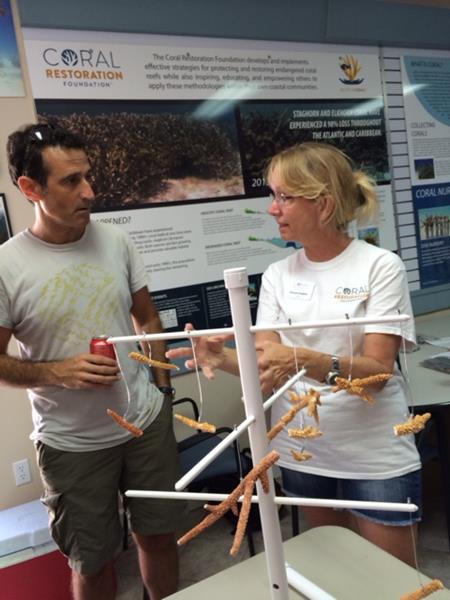

If conditions are right, we should make one dive on a reef being repopulated by carefully-categorized specimens whose growth can be measured and documented for future research purposes. We'll begin the process by chipping below the surface of dying reefs to clean away algae and debris. Then using special marine epoxy, we'll mount each piece of coral, usually about the size of your hand, at three points of attachment to the clean host surface. These transplants are categorized genus and phylum, and the location of each specimen is documented to monitor different growth rates of different corals under various conditions.
If time permits, we'll move the boat to a reef where we can see the success of prior outplanting efforts. I have seen corals that Active Divers members planted during our original programs with CRF more than 10 years ago, that are several feet high now and propagating to bring the reef back to its formal glory. For more information about CRF and its work, check out its website at www.corarestoration.org, then sign up for our June 15 program. Hope to see you there.
For questions or to request more information, please contact Roy Wasson, Conservation Director at mobile phone number 305-519-8897 or email via roy@wassonandassociates.com or ActiveDiversInfo@gmail.com.
Coral Restoration Foundation Reef Restoration Event
Florida Keys Dive Center
![]()
Any ideas? The answer is micro-plastics. This time in the form of micro-beads. Where, do you say? Toothpaste, exfoliates and other personal items. Here in the US and the UK it is being banned in personal use items, but not the rest of the world. Additionally, the United States is not banning it in commercial and industrial products. Apparently, we don’t consider it that important.
But a dump truck a MINUTE of plastics is entering our oceans. Some of the micro-plastic is formed when it breaks down and splits into small pieces. Needless to say, this cannot be collected. This is microscopic and no net is going to gather it up. Worst of all, it enters the food chain and into your body it goes. You don’t even know it’s happening. No one is measuring it or testing for it, as of yet. I hope we don’t wait until it is too late.
There is no new technology, currently on the way to solve this. Is it a crisis? Who knows, we aren’t measuring it. First you need a starting point and we don’t have it. Wish someone would start on this instead of just writing about it. But then I am the least scientific person there is, so it will depend on the Scientific Community to sound the alarm, and the politicians to take up the mantle.
![]()

Rachel Davis and Kat Leigh
Katharine "Kat" Leigh, a fisheries scientist from The Nature Conservancy, was awarded one of three Women Diver's Hall of Fame Advanced Education Scholarships. She just completed her Advanced Open Water and Nitrox certifications which were fully funded by the award. She became a member by attending our Scuba Skills Tune-Up event in Miami as part of her training.
I had only been working for The Nature Conservancy about two months when I met Kat at the Marketing Orientation at our Worldwide Office in Arlington, Virginia in March of 2018. During our first conversation she told me that she had studied fish biology in undergrad, and that to scuba dive was a lifelong dream. I invited her to come to Florida last summer to earn her PADI Open Water Diver certification, which she completed in August 2018.
I learned about the Women Divers Hall of Fame scholarship through Lenora Bach, as Juliana had won the same award a few years ago. I recommended Kat for the scholarship because she was one of my best and brightest diving students. To this day, she is the only student I've ever had make a perfect score on the Open Water final exam.
Kat is a Science Specialist for The Nature Conservancy, wearing many hats including designing a research database for the Palmyra Atoll team, working on Pacific island conservation partnership with Global Science, and supporting the Indo Pacific Tuna and the Indonesian Snapper Grouper Fisheries program. She is the founder of SmallScaleOA, an entrepreneurial venture designed to promote seafood industry resilience and coastal research in Southeast Asia. In the fall she will begin her Graduate Studies at the University of California Santa Barbara to earn her Master of Environmental Science and Management degree with an Eco-Entrepreneurship Focus. This focus is specifically designed to support students aiming to launch an environment-geared venture, which will allow her to continue her efforts with SmallScaleOA.
During one of our training dives we were given a lionfish to try out because Kat had never had it before. She cleaned and filleted it will great precision in spite of the dull knives in my kitchen, and made a wonderful sauce to go with it. She said that she was very happy that lionfish was delicious because it would encourage people to catch them and keep them off our reefs.
Congratulations Kat on all of your achievements and welcome to Active Divers!
![]()
 A barnacled Hawksbill turtlefor
the February dive.
A barnacled Hawksbill turtlefor
the February dive.
In February of this year I had the chance to try out a new dive operator called Jupiter Scuba Diving (not to be confused with Jupiter Dive Center) and their boat Kyalami. It’s docked at the Jupiter Inlet marina, home of the famous and sprawling Square Grouper Tiki Bar, which is a wonderful place for an aprčs dive bite and drink. You literally have to walk through the tiki-bar to get to the boat dock, so you can’t miss it.
Jupiter offers drift diving in swift currents the heart of the Gulf Stream, so this is rated as an Advanced dive. Jupiter delivers divers delights for every season: lemon sharks in the winter, Goliath groupers in the fall, and sea turtles in mid-summer.
This is a top notch operation. The dive briefing is thorough and done on a white board, just like on a liveaboard! They put a very knowledgeable Divemaster in the water on every dive to guide the group. The staff is friendly and courteous. The drops are accurate and the pick ups fast and efficient.
Jupiter is a hot bed for nesting sea turtles. The Divemaster told us that between mid-June and mid-July during the height of turtle nesting season you can see up to 50 turtles on a single dive! So we chose July 6 for this dive, and are calling it our Sea Turtle Dive.
Of course we can’t guarantee that we’ll see that many turtles on this dive, however, in February of this year we saw about a dozen turtles between two dives including a hawksbill rarely seen in Florida, plus numerous loggerheads, a full three months before turtle nesting season officially began.
So join us for this extraordinary dive! Click here to get a sneak peek of what we’ll experience in this video taken from our dive in February.
To book the dive, click here.
![]()
Poles to Escape Climate Change
--Reprinted from Newsweek, May 2, 2019
Reef corals in equatorial regions are going to start moving toward the poles as climate change takes hold, scientists have said. By analyzing the ranges of reefs from the fossil record, researchers are able to build a picture of how these systems respond to climate change—and then project how they might respond under future global warming.
Findings show that, under two climate change scenarios set out by the Intergovernmental Panel on Climate Change (IPCC), reefs are likely to expand their poleward range—in both the Northern and Southern hemispheres—and decline in the regions they currently occupy. This will mean a fundamental change to the locations of reef corals in the future.
The study, published in the journal Royal Society Open Science, examines the fossil record for how organisms respond to different climate states over vast timescales. Looking at the last period of global warming—the Last Interglacial, around 125,000 years ago—researchers found that reef corals moved toward the poles as oceans got warmer.
They then used a modeling system to generate a global map of suitable habitats for reef corals under different climate scenarios—one where global temperatures rise by between 1.1 and 2.6 degrees Celsius and another where it increases by between 2.6 and 4.8 degrees Celsius. The latter is essentially the IPCC’s worst-case scenario for future climate change.
Models showed that reef corals—which are the building blocks of coral reefs, sort of like trees in a forest—were greatly affected in the equatorial regions, and this appears to be driven by sea-surface temperatures. The team predicts that a substantial number of habitats suitable for reef corals will be lost as a result of warming.
Study author Lewis Jones of Imperial College London said the move toward the poles in some species is already taking place. “We will almost certainly see a decline in reef ecosystems in equatorial and tropical regions in the near future,” he told Newsweek. “Over longer timescales, we may well see the establishment of reef ecosystems at higher latitudes as we observe in the fossil record.”
He said studies and real-world observations—like major bleaching events—show that coral reef ecosystems are being negatively affected by global warming. However, evidence showing how reef corals will react in the future has been lacking.
“Global warming is happening,” he said. “As a society, we need to understand how species and ecosystems will respond to such change and how we can best negate the negative impacts but also prepare for them.”
Jones said some species are now on the move to get away from the warmer water, but whether others will be able to keep pace with the rapid rate remains to be seen. Discussing the future of reef corals, he said the next few decades will likely see a huge decline in biodiversity.
“On the century scale, our models show that if we don’t take action to reduce global warming, we could lose most of the suitable habitats in equatorial and tropical regions,” he said. “As a palaeobiologist, I like to think coral reef ecosystems would bounce back on longer timescales as they have done in the past, perhaps occupying higher latitudinal distributions in a warmer world.
“However, the rate of change we see today is quite unprecedented in geological record, so without proper conservation efforts and reduction in greenhouse gas emissions, some might say I am dreamer,” Jones said.
![]()
Have you ever seen one in the wild? I have off of Cape Cod on a whaling sightseeing trip years ago. It was amazing. I was with my kids, who are now in their 30’s and 40’s. They (the whales) went under the boat and came up the other side and you got that famous picture of the fin in the air. I still see it with clarity in my mind’s eye. I envy those that have made live sightings in the wild while scuba diving.
The blue whale (Balaenoptera musculus) is one of
the largest animals to ever live. There were plenty of them until
technology came up with the exploding harpoon gun in 1868. It is
those pesky guns again, not the people. Not to digress, which I do
easily, they had a 65 million year history going for them. But they
were not prepared for modern man.
They started disappearing quickly and looked like man would get every last one. During the mid-1900’s only 10% actually made it through. Then in 1946 The International Whaling Commission (IWC) started to regulate the numbers to be taken. They used a mathematical formula to justify the numbers taken. Not the best idea, but at least there are some left to see. I hope on one of your dives you can witness one in the wild, I hope to be next to you.
Some Blue Whale Facts:
- They eat up to 8 tons of krill a day, more than the weight of a full-grown elephant
- Their age can be estimated by the buildup of earwax, one layer for every six months. They live 80 to 90 years, and some have been found to live up to 110 years.
- Their low frequency “voice” has been measured at up to 188 decibels, louder than a jet engine. The sound will carry over 500 miles in the ocean.
- Baleen was used as “whalebone” in 19th century fashion for corsets, collars, hat brims, and skirt hoops. Baleen is actually made of keratin, the same material as fingernails.
Did you know that Active Divers offers dive insurance? You may have noticed the "Dive + Insurance" option when purchasing a dive on our schedule page. For a $5 fee at the time of booking your local dive, you may insure your dive fee against any unforeseen problem that could preclude you from making the dive.
If for any reason you are unable to attend a local dive for which you are scheduled and have paid the insurance, Active Divers will credit your dive fee to another date. The $5.00 insurance is non-transferable and non-refundable.
For more information, see the "Active Divers Trip Cancellation Insurance" description at https://activedivers.org/Guidelines.html.If you have additional questions, please send us an email message at ActiveDiversInfo@gmail.com.
 Five
new Active Divers members joined at Scuba Skills Tune Up event on
May 11: Antonio Aparicio, Carlos Cerna, Kat Leigh, Derek Prince, and
Tyler Prince. Also in attendance were returning members Frank Clark,
John Davis, Lynda Melton, and Joy Dequine. Safety Officers Dan
Baeza, Rachel Davis and Lee Wood conducted the training in and out
of the water. Thanks to Lon Von Lintel, Connie Crowther, Lenora Bach
and Roger Bach for helping with the event.
Five
new Active Divers members joined at Scuba Skills Tune Up event on
May 11: Antonio Aparicio, Carlos Cerna, Kat Leigh, Derek Prince, and
Tyler Prince. Also in attendance were returning members Frank Clark,
John Davis, Lynda Melton, and Joy Dequine. Safety Officers Dan
Baeza, Rachel Davis and Lee Wood conducted the training in and out
of the water. Thanks to Lon Von Lintel, Connie Crowther, Lenora Bach
and Roger Bach for helping with the event.
![]()
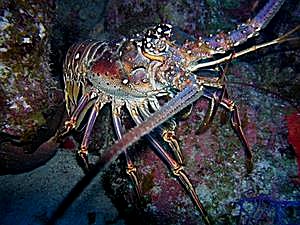
Can this be true? Well, for clarity the decapods are, that is those are the ones with the delicious claws you get in New England. Cape Cod is famous for them. So is Maine which reflects the name: Maine lobsters. You see those claws are very handy. They catch prey, but also catch other lobsters.
Now recently they have been on a binge with their own kind. Cannibalism is on the rise, at least in the lobster world. Scientists have focused on several factors. The biggest being the water temperature. This has the lobsters growing faster and reproducing more. Then there is the pesky problem of overfishing. Since the lobsters are not getting food from their regular supplies it leaves them to practice cannibalism.
The other weird fact is that these lobsters have three stomachs, guess it is for grinding up the lobster shells. Did you ever note the difference in the claws? Lobsters have two distinct claws; one is the crusher claw and the other is the ripper claw. Different claws for different work. Lastly, guess where the teeth are. If you guessed stomach, you are a lobster aficionado.
So, be careful next time you find a lobster in the wild. It might just invite you to dinner, with YOU as the main course!
Want your newsletter delivered via snail-mail? Contact the webmaster and request a printed copy. Be sure to put "Active Divers Newsletter" in the subject.
![]()
If so, please email or call us with your current information. You may send an email to: Dr. Dan Baeza, Membership Chair at ActiveDiversInfo@gmail.com. You can also call Dan at 954-260-8225 and leave a message with your new contact information.
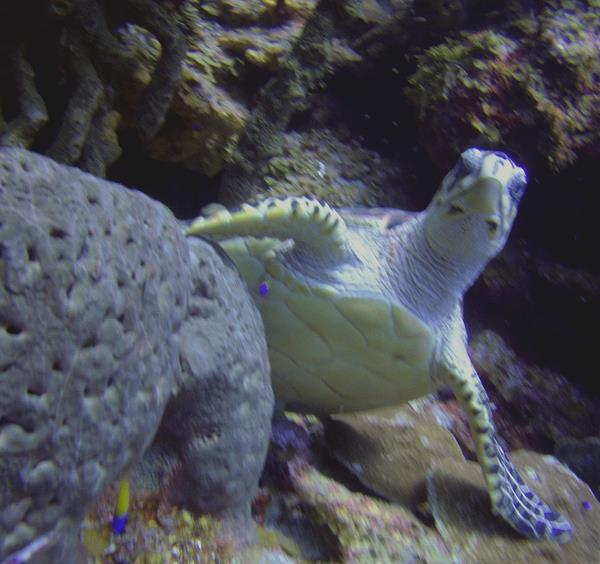
Active Divers T-Shirts For Sale
We've revamped our logo! Show your pride in the best dive club anywhere and pick up a tee with a brand new logo. Hover over the t-shirt to see the logo in detail. Sizes small, medium, large, xlarge, xxlarge. Some tank tops available also. All shirts are $10 each. CALL LON AT 305-251-4975 AND PLACE YOUR ORDER TODAY!. Lon will deliver it to you on your next dive.
How many arms does an octopus have?
a. 8
b. 6
c. None
d. As many as it needs
![]()
--reprinted from WiseGeek
When anglerfish mate, the male bites the female and fuses to her body, remaining there for the rest of their lives.
The mating behavior of ceratioid anglerfish is unusual, to say the least. The male zeroes in on the much larger female when a bioluminescent appendage on her body, called a lure, sends out pheromones. It's love at first scent. The male proceeds to bite the female and doesn't let go. Eventually, his mouth fuses with her body, and they spend the rest of their lives attached -- with the female sharing her blood, and the male supplying sperm. It’s called sexual parasitism, or the deep sea version of “til death do us part.”

